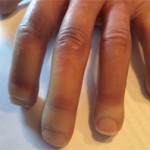During the night, Dr. Indura’s blood pressure remained elevated. At one point it reached 210/118. When we reached the maximum recommended dose of captopril, a second medication was added, and still the pressures remained unacceptably high. Her urine output diminished. The pointer and ring finger of the right hand blackened and turned stone cold. A morphine drip was hung.
Early the next morning, her blood pressure finally normalized. We didn’t expect her creatinine to improve, but I was dismayed that it continued to climb. In between my visits, multiple specialists weighed in on the case. A GI consultant ordered several studies to assess whether bacterial overgrowth syndrome was present. When scleroderma slows down the motility of the small bowel, bacteria populate areas of the bowel that are usually sterile. This may result in weight loss due to nausea, vomiting and reduced absorption of nutrients. The treatment: a low dose of an antibiotic. Unfortunately, Dr. Indura vomited the first dose, then the second, before we switched to an intravenous formulation.
Surgery declared that the pointer finger would probably need to be amputated at the middle knuckle, but now was not the time to operate. She was too unstable. Dermatology performed a forearm skin biopsy for a research study. The immunology basic science department took one sample, the dermatopathology department another—both departments searching for clues in the pathogenesis of the disease.
The pulmonologist passed a bronchoscope into the lungs and performed a transbronchial biopsy. I heard that it was touch and go during the procedure; her oxygen levels plummeted, but recovered after the bronchoscope was removed from her airway. The results would lay to rest whether an unusual infection was inflaming the lungs or active scleroderma. Post-bronchoscopy, Dr. Indura’s oxygen needs never returned to baseline. She became increasingly short of breath and restless.
The next day, I called pathology and got a wet read on the lung biopsy. The result: Severe inflammation. After notifying Dr. Medsger, I wrote the order for cyclophosphamide. Cyclophosphamide has, as doctors say when talking about a particularly toxic drug, a narrow therapeutic window. I stood at the bedside as the cyclophosphamide infused, but I was uneasy; we’re giving this lady a lot of IV fluid and it has nowhere to go. Her urine output was minimal. I called the on-call kidney fellow and he recommended high-dose furosemide to help her kidneys flush out the extra fluid. Maybe that would work.
On the fourth hospitalization day, Dr. Indura’s kidneys essentially shut down. We doubled the dose of furosemide. No response. That afternoon, Dr. Medsger sat down with Dr. Indura and her husband and discussed dialysis. He explained that although it was critical to begin dialysis, over time the kidneys could recover some degree of function. The key was to get her over this crisis. The Induras readily agreed.



